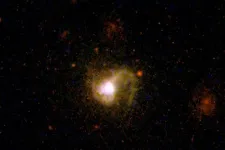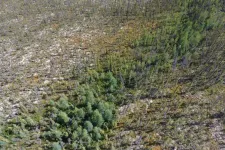Small galaxies likely played important role in evolution of the Universe
Researchers find first-ever galaxy observed in a 'blow-away' state
2021-04-29
(Press-News.org) A new study led by University of Minnesota astrophysicists shows that high-energy light from small galaxies may have played a key role in the early evolution of the Universe. The research gives insight into how the Universe became reionized, a problem that astronomers have been trying to solve for years.
The research is published in The Astrophysical Journal, a peer-reviewed scientific journal of astrophysics and astronomy.
After the Big Bang, when the Universe was formed billions of years ago, it was in an ionized state. This means that the electrons and protons floated freely throughout space. As the Universe expanded and started cooling down, it changed to a neutral state when the protons and electrons combined into atoms, akin to water vapor condensing into a cloud.
Now however, scientists have observed that the Universe is back in an ionized state. A major endeavor in astronomy is figuring out how this happened. Astronomers have theorized that the energy for reionization must have come from galaxies themselves. But, it's incredibly hard for enough high energy light to escape a galaxy due to hydrogen clouds within it that absorb the light, much like clouds in the Earth's atmosphere absorb sunlight on an overcast day.
Astrophysicists from the Minnesota Institute for Astrophysics in the University of Minnesota's College of Science and Engineering may have found the answer to that problem. Using data from the Gemini telescope, the researchers have observed the first ever galaxy in a "blow-away" state, meaning that the hydrogen clouds have been removed, allowing the high energy light to escape. The scientists suspect that the blow-away was caused by many supernovas, or dying stars, exploding in a short period of time.
"The star-formation can be thought of as blowing up the balloon," explained Nathan Eggen, the paper's lead author who recently received his master's degree in astrophysics from the University of Minnesota. "If, however, the star-formation was more intense, then there would be a rupture or hole made in the surface of the balloon to let out some of that energy. In the case of this galaxy, the star-formation was so powerful that the balloon was torn to pieces, completely blown-away."
The galaxy, named Pox 186, is so small that it could fit inside the Milky Way. The researchers suspect that its compact size, coupled with its large population of stars--which amount to a hundred thousand times the mass of the sun--made the blow-away possible.
The findings confirm that a blow-away is possible, furthering the idea that small galaxies were primarily responsible for the reionization of the Universe and giving more insight into how the Universe became what it is today.
"There are a lot of scenarios in science where you theorize that something should be the case, and you don't actually find it," Eggen said. "So, getting the observational confirmation that this sort of thing can happen is really important. If this one scenario is possible, then that means that there are other galaxies that also existed in blow-away states in the past. Understanding the consequences of this blow-away gives direct insight into the impacts similar blow-aways would have had during the process of reionization."
INFORMATION:
In addition to Eggen, the research team included Claudia Scarlata and Evan Skillman, both professors in the School of Physics and Astronomy at the University of Minnesota, and Anne Jaskot, an assistant professor of astronomy at Williams College.
The research was funded by grants from the University of Minnesota and NASA. Researchers made use of the NASA/IPAC Extragalactic Database (NED) and NASA's Astrophysical Data System.
Read the full paper entitled, " END
[Attachments] See images for this press release:

ELSE PRESS RELEASES FROM THIS DATE:
2021-04-29
In August 2016 a massive storm on par with a Category 2 hurricane churned in the Arctic Ocean. The cyclone led to the third-lowest sea ice extent ever recorded. But what made the Great Arctic Cyclone of 2016 particularly appealing to scientists was the proximity of the Korean icebreaker Araon.
For the first time ever, scientists were able to see exactly what happens to the ocean and sea ice when a cyclone hits. University of Alaska Fairbanks researchers and their international colleagues recently published a new study showing that sea ice declined ...
2021-04-29
Older adults were significantly affected by isolation and stress during Oregon's initial COVID-19 lockdown last spring, but they were also able to find connection and meaning in community, new hobbies and time for themselves, a recent Oregon State University study found.
If resilience is understood as the ability to see positives in the midst of a negative situation, then many of the study's participants demonstrated resilience during that time, the researchers said.
"A lot of times we think about resilience as a personality trait, and it's true that there are some qualities that may help people experience that. But in the end, resilience is something that is shared," said Heidi Igarashi, ...
2021-04-29
DALLAS, April 29, 2021 – Last Friday, the Centers for Disease Control and Prevention (CDC) and the U.S. Food & Drug Administration (FDA) lifted the pause in administration of the Johnson & Johnson (Janssen) COVID-19 vaccine in the U.S. The temporary pause was due to reports of a serious condition called cerebral venous sinus thrombosis (CVST), which refers to blood clots in the brain’s veins - not in the arteries, as is the case for most strokes - in combination with thrombocytopenia (low blood platelet count). CVST and thrombocytopenia together is called thrombosis-thrombocytopenia syndrome (TTS). When TTS is linked to receiving a COVID-19 vaccine, it is called vaccine-induced immune thrombotic thrombocytopenia ...
2021-04-29
Tomorrow's cutting-edge technology will need electronics that can tolerate extreme conditions. That's why a group of researchers led by Michigan State University's Jason Nicholas is building stronger circuits today.
Nicholas and his team have developed more heat resilient silver circuitry with an assist from nickel. The team described the work, which was funded by the U.S. Department of Energy Solid Oxide Fuel Cell Program, on April 15 in the journal Scripta Materialia.
The types of devices that the MSU team is working to benefit -- next-generation fuel cells, high-temperature semiconductors and solid oxide electrolysis cells -- could have ...
2021-04-29
New research indicates that the computer-based models currently used to simulate how Earth's climate will change in the future underestimate the impact that forest fires and drying climate are having on the world's northernmost forests, which make up the largest forest biome on the planet. It's an important understanding because these northern forests absorb a significant amount of Earth's carbon dioxide.
The finding, reached by studying 30 years of the world's forests using NASA satellite imaging data, suggests that forests won't be able to sequester as much carbon ...
2021-04-29
In a novel effort to combat COVID-19 misinformation, a group of women researchers, including nurse scientists from the University of Pennsylvania School of Nursing (Penn Nursing), launched the Dear Pandemic social media campaign in March 2020. It delivers curated, comprehensive, and timely information about the COVID-19 pandemic in a question-and-answer format. Complex topics such as COVID-19 aerosol transmission, risk reduction strategies to avoid infection, and excess mortality are explained in common language and shared widely.
Now with more than 100,000 followers and accounts on Facebook, ...
2021-04-29
FINDINGS
A UCLA-led study shows that physicians frequently order preventive medical services for adult Medicare beneficiaries that are considered unnecessary and of "low value" by the U.S. Preventive Services Task Force -- at a cost of $478 million per year.
The researchers analyzed national survey data over a 10-year period, looking specifically at seven preventive services given a "D" rating by the task force, and discovered that these services were ordered more than 31 million times annually.
BACKGROUND
The U.S. Preventive Services Task Force, an independent panel appointed by the Department of Health and Human Services, makes recommendations on the value of clinical preventive ...
2021-04-29
The field of soft robotics has exploded in the past decade, as ever more researchers seek to make real the potential of these pliant, flexible automata in a variety of realms, including search and rescue, exploration and medicine.
For all the excitement surrounding these new machines, however, UC Santa Barbara mechanical engineering professor Elliot Hawkes wants to ensure that soft robotics research is more than just a flash in the pan. "Some new, rapidly growing fields never take root, while others become thriving disciplines," Hawkes said.
To help guarantee the longevity of soft robotics ...
2021-04-29
New York, NY--Research-practice partnerships (RPPs), long-term collaborations between researchers, policy makers and practitioners, represent an especially promising strategy for making sure that all children benefit from early childhood education, according to END ...
2021-04-29
People living with a child who attends school in-person have an increased risk of reporting evidence of COVID-19, but teacher masking, symptom screening, and other mitigation measures in schools may be able to minimize that excess risk, suggests a study led by researchers at the Johns Hopkins Bloomberg School of Public Health.
For their study, the researchers analyzed nearly 600,000 responses from an ongoing Facebook-based COVID-19 symptom survey in the United States over two periods between November 2020 and February 2021 before vaccines were widely available in the U.S. The researchers found that those living with a child engaged in full-time, ...
LAST 30 PRESS RELEASES:
[Press-News.org] Small galaxies likely played important role in evolution of the Universe
Researchers find first-ever galaxy observed in a 'blow-away' state


